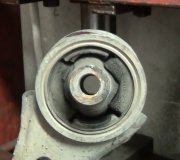Hi clawrence85. Welcome to the forum. Shock absorbers have nothing to do with ride height. The springs are the only thing to look at. The place to start is by measuring the height to find out if the rear really is low or if the front is too high. I can't remember if this applies to both the rear-wheel-drive and four-wheel-drive models, but every Blazer I've worked on had torsion bars in the front. Those are adjustable and someone cold have adjusted them up too much. Misadjusted ride height can have an adverse affect on tire wear even when it's set properly on the alignment rack. The geometry is changed causing the wheels to go through incorrect angle changes as the body goes up and down over bumps.
Any tire and alignment shop will have a ride height guide that spells out exactly where to measure and what each measurement should be. If the rear is indeed low, and you have leaf springs, you'll have to see the alignment shop to have them re-arced or replaced. You can also add a pair of helper springs but sometimes they cause squeaking noises.
If you have rear coil springs, they are real easy to replace yourself. Support the vehicle by the frame with jack stands after you unbolt the lower shock absorber bolt on one side. Raise the axle with a floor jack so you can unhook the shock absorber, then let the axle down and the spring will just about fall out. Do just one side at a time because if both shock absorbers are unbolted at the same time, the only thing holding the axle up when you lower the floor jack will be the rubber brake hose! You can leave the tires on. In fact, you might have to get a helper to push the tire down so you can lift the old spring out and the new one in. The springs must be positioned correctly too. The ends of the top and bottom coils will be the same on the new springs as on the old springs. Use string or wire to tie the rubber isolator to the top of the spring so it doesn't fall off while you're lifting the spring into position.
Many high quality aftermarket springs will actually be shorter than your old ones but they are stiffer. Some are variable rate. The coils that are further apart provide the smooth ride quality, and the coils that are close together provide the load carrying capacity.
Caradiodoc
Sunday, August 22nd, 2010 AT 3:12 AM


